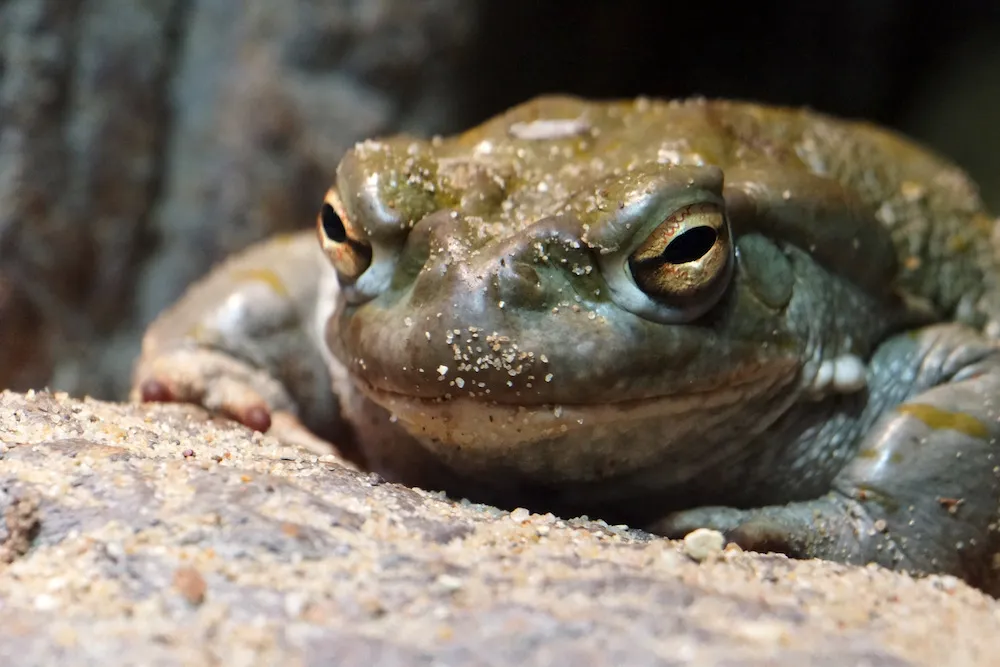If you’ve ever experienced 5-MeO-DMT (also known as the God Molecule or Bufo), you may have found yourself in a realm where colors give way to an infinite expanse of white light, time folds in upon itself, and your very essence merges with the infinite. It’s a place of extraordinary intensity where the boundaries of your mind dissolve, revealing the interconnectedness of all existence.
Such is the nature of 5-MeO-DMT, a powerful psychedelic compound known for its ability to catapult individuals into profound and transformative experiences.
But what if there was an alternative path, a gentler journey that invites exploration and insight without overwhelming intensity? Enter low-dose 5-MeO-DMT, an emerging approach that may allow people to tap into the power of the “God Molecule” in subtler, yet equally profound ways. 5-MeO-DMT offers researchers and clinicians a chance to explore the mind’s mysteries, providing a guide to self-discovery and healing.
Recently, I had the chance to speak with two pioneers in the field of low-dose psychedelics. Axle Davids and Ari Franklin of The Pattern Project aim to shed light on the benefits and possibilities of low-dose 5-MeO-DMT experiences. In a riveting conversation, we delved into their goal to discover novel applications for low-dose 5-MeO-DMT, ongoing research, and the exciting potential of this compound for mental health and well-being.
Keep Up with Uncensored Psychedelic Trends
Join our newsletter at Psychedelics Uncensored.
We respect and protect your privacy. By subscribing your info will be subject to our privacy policy . Unsubscribe easily at any time
What is 5-MeO-DMT?
5-MeO-DMT, or 5-methoxy-N,N-dimethyltryptamine, is a naturally occurring psychoactive substance found in certain plants and in the parotid gland secretions of the Bufo alvarius toad (also known as the Colorado River toad or the Sonoran Desert toad). It is a relative of N,N,DMT (N,N-dimethyltryptamine), but its effects are quite different and often more intense. 5-MeO-DMT also differs from N,N,DMT by being less narrative, while having a more emotional and cathartic effect.(1)

Unlike other psychedelics, which can have effects that last several hours, 5-MeO-DMT is best known for its intensity and brevity (sometimes lasting 20 minutes or less). Despite being so short-acting, it still has significant therapeutic potential that may rival that of other, better-known, entheogens like psilocybin. One study involving 20 participants found that 75% of the individuals involved reported significant mystical and spiritual experiences.(2)
The body of scientific evidence supporting the clinical use of 5-MeO-DMT is also about to explode, with 10 clinical trials currently active or recruiting, and an additional five that have been completed and will soon publish results.(3)
The Pattern Project: Exploring Low-Dose 5-MeO-DMT Experiences
The journey of The Pattern Project began about two and a half years ago when Founder Axle Davids discovered a lack of information on low-dose 5-MeO-DMT experiences. This realization sparked his curiosity, leading him to investigate the potential benefits of combining low doses of 5-MeO-DMT with mindfulness practices. Ari Franklin, an epidemiologist and researcher, joined the project as Director, aiming to evaluate and analyze these experiences more formally.
“When I searched the Internet for 5-MeO-DMT and meditation, I got nothing,” Davids says. “That started a journey of learning how to meditate with low-dose 5-MeO-DMT, but the doses were too strong. Then, I was one of the first students at a retreat called Bridging Heaven, where I learned how to meditate with low doses. After that, I experimented with even lower doses and was delighted to discover it was almost like using a different substance. It was so gentle, grounding in the present moment, and insight-generating when combined with mindfulness practices.”
Through their initial research, The Pattern Project has observed some remarkable results. Beginning with the launch of a survey designed to capture a glimpse of how people were using 5-MeO-DMT, they discovered that individuals who have experimented with low-dose formulations and engaged in mindfulness practices reported deeper meditations, more present awareness in daily life, and therapeutic experiences. With the low doses, these individuals remained in control and present throughout their experiences, making the combination of low-dose 5-MeO-DMT and mindfulness an intriguing area for further exploration.
Keep Up with Psychedelic Trends
Get uncensored psychedelic news, events, and updates. Join Psychedelics Uncensored!
We respect and protect your privacy. By subscribing your info will be subject to our privacy policy . Unsubscribe easily at any time
“For some individuals, low-dose 5-MeO-DMT appears to be associated with shifts in meditation quality, heightened mind-body connections, therapeutic insights, and emotional release,” Davids says.
According to Davids, low-dose 5-MeO-DMT has unique applications especially compared to the challenges of macro-dosing psychedelics. “We are looking at something that’s short-lasting, appears to have a safer profile, and benefits for mindfulness, therapy, and other uses,” he explains.
Davids and Franklin believe that low-dose 5-MeO-DMT, as a form of psycholytic therapy, could offer a new way to utilize psychedelic medicine that is both gentler on the patients, and more accessible. This latter point could prove particularly fruitful given the recent controversy surrounding the capitalistic approach to psychedelic medicine.
Current conventions stipulate that two psychiatric professionals be on hand during psychedelic therapy sessions. This is due, in part, to the length of a psychedelic therapy session. Some of which can last as long as eight hours. This current model’s costs can reach as high as ten thousand dollars per session, or sometimes more, often making therapy inaccessible to those who need it most. If low-dose 5-MeO-DMT therapy were to gain prevalence, this could possibly be reduced to a single therapist, and for a much shorter period of time, which would significantly lower costs and help more people receive therapy services.
Building Research Protocols: Understanding the Impacts
To gain a deeper understanding of these experiences, The Pattern Project is launching a longitudinal observational study to collect data on people’s experiences with low-dose 5-MeO-DMT, and the impacts over time on mental health and mindfulness. The study will include quantitative and qualitative measures and provide insights on benefits and safety to inform future clinical trials. According to Davids, this allows them also to “understand people’s experiences – those who are meditating and those who aren’t.” Adding, “We’ve been building out projects since the initial case reports trying to understand what the impacts are.”
“We aim to formally investigate the effects, identify applications, and build partnerships to grow our projects,” Franklin says. “This includes work with clinicians and mindfulness practitioners, research institutes, industry, and other communities who could benefit from low-dose 5-MeO-DMT.”
The initial findings suggest that low-dose 5-MeO-DMT may significantly benefit mental health, mindfulness, and therapy. However, the research is still in its early stages, and the team emphasizes the need for further investigations to establish a stronger evidence base. They aim to develop protocols and encourage more research.
Differentiating Low-Dose and High-Dose Experiences
One crucial aspect of The Pattern Project’s work is distinguishing between low-dose and high-dose experiences. High doses of 5-MeO-DMT often lead to ego dissolution, where individuals report a sense of becoming one with everything. On the other hand, low-dose experiences are characterized by emotional depth while allowing individuals to remain present and conscious.
When asked what exactly low-dose 5-MeO-DMT is, Franklin said, “We’re typically talking about one milligram or less if vaporized. In some cases, much lower. We’ve had reports of people having significant, deep insights at even a third of a milligram. For instance, a 23-year-old young lady who was quite unhappy – an overachiever – felt somewhat alienated. She reported that just a third of a milligram allowed her to be in the moment for the first time in her life. She said it was the first time that she didn’t feel like she was being chased by her past or had to worry about the future”
The first protocol being released by The Pattern Project is on meditating with low-dose 5-MeO-DMT. Meditation was the first application to fascinate Axle Davids, and both he and Ari Franklin have gathered data on this practice. “We recently interviewed someone in their forties, an executive, who told us about using a 5-MeO-DMT pen over one month,” Davids says. “He had never been able to consistently maintain a meditation practice. Now, he’s built up a practice, and as a result of using the pen and meditating consistently, he’s less reactive, more mindful, and less stressed in different situations. Most interestingly, he doesn’t rely on the low dose to meditate.”
According to The Pattern Project team, low-dose 5-MeO-DMT has also shown potential benefits for relationships. One user shared how it aided him during a challenging time in his marriage, helping him to “connect with his wife in a more supportive, empathetic way.”
These experiences have spurred Franklin and Davids to further understand this phenomenon. “It’s interesting… low-dose 5-MeO-DMT has a profile that could increase the acceptance of psychedelics in society,” Franklin says. “Its short-lasting effects are typically gentle, and participants often report integrating insights from the experiences into daily life. More analysis is needed, but I’m optimistic that we will uncover new applications of this compound.”
The Pattern Project’s research is supported by a recent Phase I clinical trial conducted by GH Research, which examined several 5-MeO-DMT dosages and their various effects and safety in healthy volunteers. The researchers found that even at doses as low as two milligrams, 5-MeO-DMT produced “significant psychedelic experiences,” as measured by several questionnaires, including the Peak Experience Scale (PES), the Mystical Experience Questionnaire (MEQ) and the 5-Dimensional Altered States of Consciousness Questionnaire (5D-ACS), among others.(4)
Their current focus is on mindfulness and therapeutic insights. However, more directions may emerge as more participants are brought into the studies. At the initial stages of this research, the approach involves conducting observational studies of adults who have been using 5-MeO-DMT to comprehend their experiences better.
Safety Considerations and Future Research
Regarding low-dose 5-MeO-DMT experiences, The Pattern Project emphasizes the importance of safety and responsible use. While low doses may have a safer profile, certain contraindications exist. Individuals taking specific medications or with certain medical conditions, such as cardiovascular diseases or liver or kidney failure, may not be suitable candidates for these experiences. The team is dedicated to understanding these safety parameters and ensuring responsible exploration of this substance. In the near future, they will release an educational resource focused on harm reduction.

“There are certain medications and conditions that are contraindicated, meaning harms may occur with use,” Franklin says. “For example, a class of antidepressants called MAOIs, lithium, and some mental health conditions like schizophrenia and other psychotic disorders.”
Low-dose applications of 5-MeO-DMT also have another important safety benefit. They may be less likely to cause an adverse event (aka. a bad trip). According to Davis, “There are a significant number of people who have a (brief) but challenging experience, and experience ontological shock that can take a long time to recover from. There are even those of us who have a very positive experience overall, but also experience ego death.”
Ego death is the loss of an individual’s subjective identity, and while some research indicates that this could be an important part of the psychedelic puzzle, it is also something that can be distressing, especially for those who may not be prepared for or expecting such an event to occur.(5)
Although currently focused on wellness and mindfulness, The Pattern Project is looking to the future. Davids and Franklin envision expanding their research into collaboration with clinicians, researchers, and others. They highlight the potential of low-dose 5-MeO-DMT as a therapeutic tool, especially in repeat sessions for psycholytic therapy. The short duration and safer profile of low-dose experiences make them accessible to a wider range of individuals and hold promise for various mental health applications, such as treating depression, anxiety, and trauma.
The sort of innovation and forward-thinking research spearheaded by Franklin and Davids represents part of the future of psychedelic medicine. By focusing on novel uses for low-dose psychedelics they may be able to open the door to new therapies that are affordable, accessible, and safe, and, most importantly, life-changing.
Sources

1. Reckweg, J. T., Uthaug, M. V., Szabo, A., Davis, A. K., Lancelotta, R., Mason, N. L., & Ramaekers, J. G. (2022). The clinical pharmacology and potential therapeutic applications of 5-methoxy-N,N-dimethyltryptamine (5-MeO-DMT). Journal of Neurochemistry. https://doi.org/10.1111/jnc.15587
2. Barsuglia, J., Davis, A. K., Palmer, R., Lancelotta, R., Windham-Herman, A.-M., Peterson, K., Polanco, M., Grant, R., & Griffiths, R. R. (2018). Intensity of Mystical Experiences Occasioned by 5-MeO-DMT and Comparison With a Prior Psilocybin Study. Frontiers in Psychology, 9. https://doi.org/10.3389/fpsyg.2018.02459
3. CTG Labs – NCBI. (n.d.). Clinicaltrials.gov. Retrieved August 16, 2023, from https://clinicaltrials.gov/search?term=5-meo-dmt&page=1
4. Reckweg, J., Mason, N. L., van Leeuwen, C., Toennes, S. W., Terwey, T. H., & Ramaekers, J. G. (2021). A Phase 1, Dose-Ranging Study to Assess Safety and Psychoactive Effects of a Vaporized 5-Methoxy-N, N-Dimethyltryptamine Formulation (GH001) in Healthy Volunteers. Frontiers in Pharmacology, 12. https://doi.org/10.3389/fphar.2021.760671
5. Nour, M. M., Evans, L., Nutt, D., & Carhart-Harris, R. L. (2016). Ego-Dissolution and Psychedelics: Validation of the Ego-Dissolution Inventory (EDI). Frontiers in Human Neuroscience, 10(269). https://doi.org/10.3389/fnhum.2016.00269
This material is not intended as a replacement or substitute for any legal or medical advice. Always consult a medical professional about your health needs. Psychedelics are widely illegal in the United States, and readers should always be informed about local, state, and federal regulations regarding psychedelics or other drugs.

 David Connell
David Connell